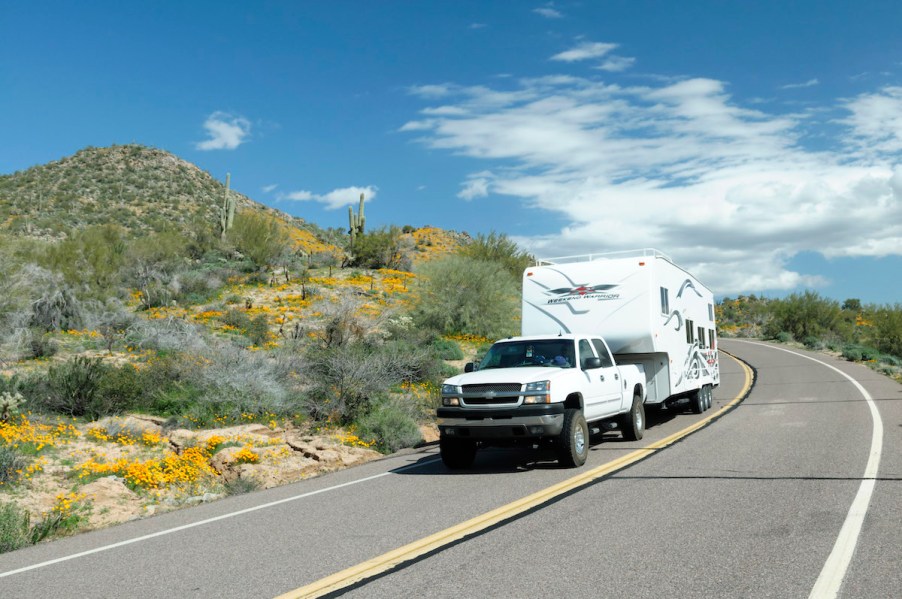
Can You Increase the Towing Capacity of an RV Rig?
Dreams of an RV adventure can be intoxicating. You can hitch your camper to the back of the family vehicle and go wherever the road takes you. But first, you’ll have to consider some essential details before setting out with your RV. Two of the most important are your travel trailer’s weight and your vehicle’s towing capacity. Is its towing capacity high enough for everything you want to trailer? If not, can you increase the towing capacity of your RV rig to suit your needs?
You can increase your RV rig’s towing capacity with some upgrades

Ensuring the weight of your fully packed RV falls under your vehicle’s towing capacity is crucial. The safety of your riders and others on the road depends on this detail. It can also cause costly wear-and-tear on your towing vehicle.
What if you can’t find the right-size RV for your towing vehicle? Is it possible to increase your rig’s towing capacity?
The answer is yes, but it will require the following upgrades, according to RV Share:
- Get the right hitch: Purchase a hitch rated for the weight of your RV, and get a weight distribution hitch.
- Use a programmer: Your towing vehicle might not have enough horsepower and torque for the fuel efficiency settings. A programmer can adjust these settings in the vehicle’s computer to get the power you need.
- Replace the axles: Replace your rig’s axles with heavy-duty versions. One way to do that is to use RV parts instead of truck parts.
- Upgrade the braking system: Upgrade your towing vehicle’s braking system by changing the brake pads and rotors. Also, ensure the RV has a braking system to help you stop.
- Install a larger radiator: Towing an RV makes your vehicle work hard and that extra effort can make it hot under the hood. It makes sense to get a bigger radiator to help cool things off.
- Upgrade the suspension: Getting a better suspension can help where the weight distribution hitch falls short.
- Enhance the intake and exhaust: Replacing the stock parts of your RV rig’s intake and exhaust with heavy-duty parts can help your vehicle “breathe better” and, thus, perform better.
Here’s how to figure out your RV rig’s towing capacity
To figure out your RV rig’s towing capacity, you’ll need to understand several terms.
Inside the driver’s-side door frame is a certification sticker or plate with essential acronyms. You can also find this information in your vehicle’s owner’s manual. First, you’ll see the GVWR (gross vehicle weight rating). That is the total weight your vehicle can handle without a trailer. Next is the GVW (gross vehicle weight) — the vehicle’s estimated total weight with all fluids, passengers, and cargo.
Third, you will see the GCWR (gross combined weight rating). That is the weight of the vehicle, passengers, cargo, and trailer with a load and the maximum weight the vehicle can handle. Last, there’s the GAWR (gross axle weight rating). It’s the maximum amount of weight a single axle can take.
How do you determine your towing capacity?
In simple terms, you want to ensure the weight of your RV and its load doesn’t exceed your RV rig’s GVWR.
The key is to add everything that will contribute to the weight the vehicle will have to carry or haul. That includes the vehicle itself, passengers, cargo, and the RV. Don’t forget bedding, linens, clothes, camping supplies, food, water, toys, etc.
Don’t believe these myths about towing
Be aware of these myths about towing that aren’t true:
Myth: The trailer bearings never need maintenance.
Truth: Performing regular upkeep on your trailer bearings is a must. A lack of proper maintenance can lead to breakdowns and expensive repairs.
Myth: Any hitch extension will work.
Truth: Get the right hitch extension for your RV rig. You’ll need the correct measurements for your vehicle to get the proper fit.
Myth: You can estimate tongue weight.
Truth: Never exceed the tongue weight. Therefore, it can be detrimental to estimate the tongue weight.


